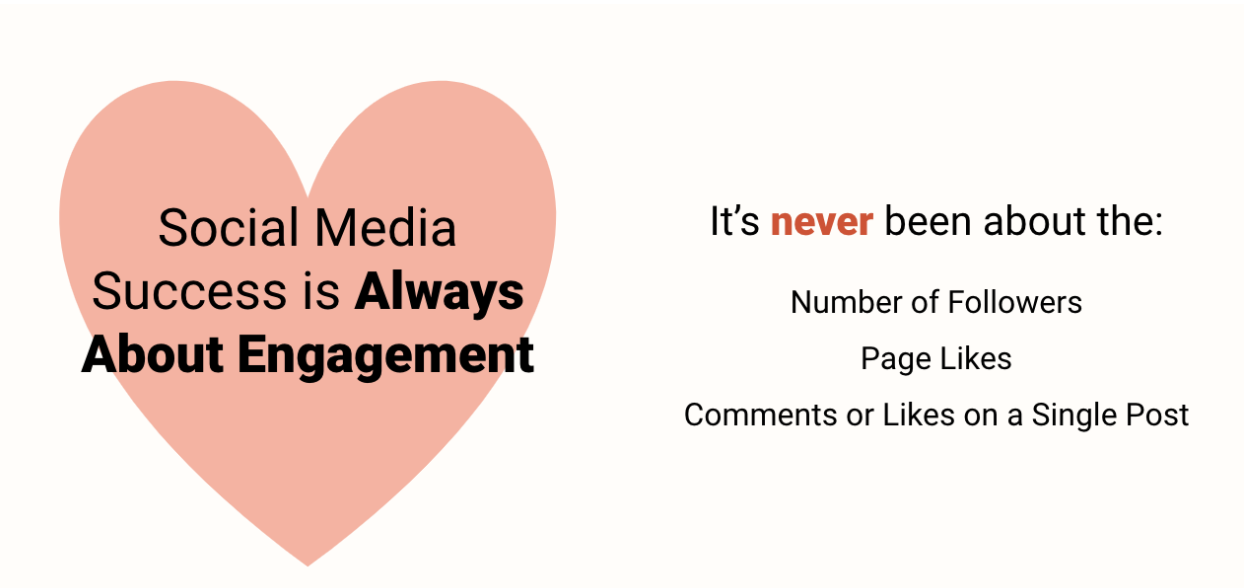Do you know how to grow your brand's social media presence in an authentic way? Building your presence organically (that means without paid advertising) takes creativity, patience, and above all, commitment. Whether you’re building your brand’s social media presence from scratch or growing what you have, these lessons can help you save time and accelerate your growth.
1. Content is king, but engagement is the key to the kingdom
Many people think that if you have great content your social media presence (and website traffic) will naturally grow exponentially. Unfortunately crafting great content will only get you so far. If you don’t listen to your audience and engage with them, nothing else matters.
As we talk about engagement, it’s important that we define what it actually is. Engagement is a signal from your audience that your content is valuable. Although engagement is measured differently on all social platforms, it’s generally defined by the number of interactions, such as likes, comments, shares, and clicks, your posts receive. When your brand consistently receives engagement, that triggers the social media channel’s algorithm to show the post to more people.
Take a moment to reflect upon the brands you engage with on social media. How has your view of them (or dare we say relationship) changed over time? When people consistently engage with your posts, their trust in your brand will likely increase. Over time, this can also lead to an improved reputation for your brand. It’s truly a magical moment when you start to see your audience recommend your brand based on the value you provide them on social media and not based upon your product.
2. Prioritize your “why”
Many edtech entrepreneurs feel like they have to talk about their products and services as much as possible. The harsh reality is that no one cares about your product. Educators are incredibly busy and the last thing they want is to experience another brand talking at them about their products and not listening to them or providing them with things that can solve the problems they have now.
Every single company started with a passionate entrepreneur who saw a real problem that they wanted to solve. Unfortunately, this passion can be lost as the pressure increases to gain as many customers as possible. As a result, many brands go for the hard sell and just talk about their product.
Instead of being product-centered and talking at your audience, consider talking with them. Talk about things that they value most. For example, if you’re a brand that’s built upon social and emotional learning (SEL), why not create helpful resources about SEL and elevate and collaborate with powerful voices in the field? Connect to your audience in a personal way that helps them understand your passion and your “why” and we promise it’ll help you achieve whatever your objectives are.
3. Avoid placing too much value on vanity metrics
Many brands tend to hang their hats on vanity metrics, such as page followers/likes. Although these can signal your potential reach, it can represent an audience that at some point wanted to connect with your brand. However, it does not represent your actual reach. We get it. It’s easy to get swept up in big numbers but bigger doesn’t always mean better. Consider the below scenario. What would you prefer? Your Marketing Director reports that your brand (across your social media channels):
1. Now has a combined 2 million followers
OR
2. Gains 1 million impressions monthly and their average reach per post has increased at least 25% .
It’s a bit of a leading question but if it’s not clear, any metric that is static and does not provide context on actual engagement or reach isn’t useful without more questioning to understand its impact. If anyone reports scenario A to you, I’d like you to immediately ask the following questions:
What’s our average growth of followers, and has this increased or decreased lately? How do we know that we are attracting our target audience?
And the kicker: What percentage of our followers are we consistently reaching and engaging with?
Pro tip: Never ever buy followers. Building the right kind of audience means creating a loyal audience that is interested in you and your content and buying followers can often mean developing an audience outside of your target market. As a social media agency, we can personally tell you that brands then hire us to unfollow (or get rid of) those followers and it takes a lot of time and effort to detangle the mess of followers to ensure you’re spending your time talking to your audience.
4. Social media ROI should not be solely judged based on referral traffic
In the past, many brands viewed social media just as a way to drive traffic to their website. We call this the “Hub and Spoke” model, where each social media channel solely exists to drive traffic to a website, and furthermore, its success is judged solely by the amount of traffic that gets referred.
This is a very limited way to look at the benefit of social media. By doing this, it ignores the many opportunities that social media provides, such as the ability to reach, expand, and engage your audience in ways that were not possible before. As each social media channel has evolved, it has also developed unique audiences with different needs and behaviors, which provides fun and innovative ways to showcase your product and content that matter to your audience.
The way to win on social media requires a mind shift to think as channel specific as possible. To do that, you’ll need to develop different and unique experiences for each channel that engage your audience. We no longer live in a world where you create one piece of content and “push it out” to each channel in the same way. Instead, social media should be at the forefront of content creation, and teams should brainstorm ways to create channel-specific experiences based on a topic or an initial piece of content.
If you’re in need of inspiration for types of content you could include across platforms, we developed this infographic of all the social media post types, building off the capabilities of each platform.
5. Different channels serve different audiences
Social media continues to evolve its functionality and features and new channels come and go all of the time. They also attract their own unique audiences with their own unique behaviors and norms. As a starting point, you should always understand each platform’s dominant demographics. This can give you insight into where your audience may initially be located, and it can also help you how prioritize which channels your brand should build a presence on.
However, given how big some of the platforms have become (who isn’t on Facebook!?), you may also choose to interpret this data in a more creative way. Ask yourself, “Can I gain attention from people in an authentic and unique way that hasn’t been done before?” Social media is all about the race for attention, so if you feel that you can confidently reach and engage your target audience in a way that hasn’t been done before that will consistently deliver value to them, do it!
6. Finally, none of this matters if you don’t find the magic in the middle
As we mentioned, different social media channels crave different types of content, have different features and capabilities, and serve different audiences and behaviors. But you don’t want to just chase your audience’s needs without factoring in your needs as an organization. On top of that, what your organization can actually do in terms of capacity, budget, and unique value add, should also be considered.
It’s not until these three distinct dimensions are compared and ultimately combined that you understand your brand’s “magic in the middle.” This ensures you are equally weighing your audience’s needs and your business’ needs, along with providing context on your organization’s capacity, budget, and capabilities.
Where the overlap occurs is where you’ll be able to save time, be strategic, and accelerate your organic social media growth.










